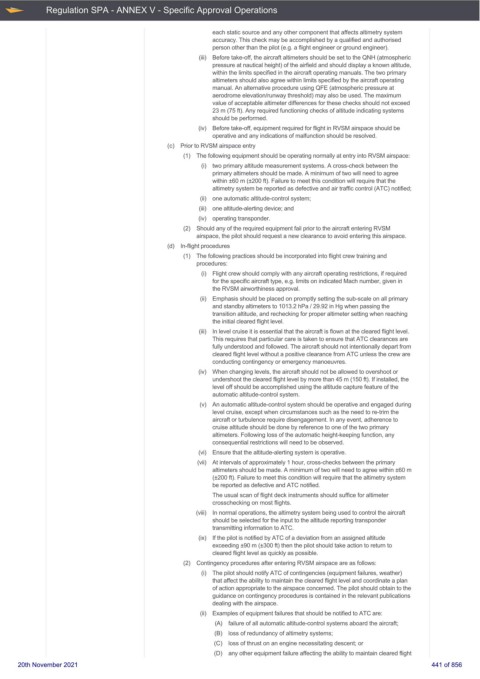Page 441 - UK Air Operations Regulations 201121
P. 441
~
~ Regulation SPA - ANNEX V - Specific Approval Operations Centrik
each static source and any other component that affects altimetry system
accuracy. This check may be accomplished by a qualified and authorised
person other than the pilot (e.g. a flight engineer or ground engineer).
(iii) Before take-off, the aircraft altimeters should be set to the QNH (atmospheric
pressure at nautical height) of the airfield and should display a known altitude,
within the limits specified in the aircraft operating manuals. The two primary
altimeters should also agree within limits specified by the aircraft operating
manual. An alternative procedure using QFE (atmospheric pressure at
aerodrome elevation/runway threshold) may also be used. The maximum
value of acceptable altimeter differences for these checks should not exceed
23 m (75 ft). Any required functioning checks of altitude indicating systems
should be performed.
(iv) Before take-off, equipment required for flight in RVSM airspace should be
operative and any indications of malfunction should be resolved.
(c) Prior to RVSM airspace entry
(1) The following equipment should be operating normally at entry into RVSM airspace:
(i) two primary altitude measurement systems. A cross-check between the
primary altimeters should be made. A minimum of two will need to agree
within ±60 m (±200 ft). Failure to meet this condition will require that the
altimetry system be reported as defective and air traffic control (ATC) notified;
(ii) one automatic altitude-control system;
(iii) one altitude-alerting device; and
(iv) operating transponder.
(2) Should any of the required equipment fail prior to the aircraft entering RVSM
airspace, the pilot should request a new clearance to avoid entering this airspace.
(d) In-flight procedures
(1) The following practices should be incorporated into flight crew training and
procedures:
(i) Flight crew should comply with any aircraft operating restrictions, if required
for the specific aircraft type, e.g. limits on indicated Mach number, given in
the RVSM airworthiness approval.
(ii) Emphasis should be placed on promptly setting the sub-scale on all primary
and standby altimeters to 1013.2 hPa / 29.92 in Hg when passing the
transition altitude, and rechecking for proper altimeter setting when reaching
the initial cleared flight level.
(iii) In level cruise it is essential that the aircraft is flown at the cleared flight level.
This requires that particular care is taken to ensure that ATC clearances are
fully understood and followed. The aircraft should not intentionally depart from
cleared flight level without a positive clearance from ATC unless the crew are
conducting contingency or emergency manoeuvres.
(iv) When changing levels, the aircraft should not be allowed to overshoot or
undershoot the cleared flight level by more than 45 m (150 ft). If installed, the
level off should be accomplished using the altitude capture feature of the
automatic altitude-control system.
(v) An automatic altitude-control system should be operative and engaged during
level cruise, except when circumstances such as the need to re-trim the
aircraft or turbulence require disengagement. In any event, adherence to
cruise altitude should be done by reference to one of the two primary
altimeters. Following loss of the automatic height-keeping function, any
consequential restrictions will need to be observed.
(vi) Ensure that the altitude-alerting system is operative.
(vii) At intervals of approximately 1 hour, cross-checks between the primary
altimeters should be made. A minimum of two will need to agree within ±60 m
(±200 ft). Failure to meet this condition will require that the altimetry system
be reported as defective and ATC notified.
The usual scan of flight deck instruments should suffice for altimeter
crosschecking on most flights.
(viii) In normal operations, the altimetry system being used to control the aircraft
should be selected for the input to the altitude reporting transponder
transmitting information to ATC.
(ix) If the pilot is notified by ATC of a deviation from an assigned altitude
exceeding ±90 m (±300 ft) then the pilot should take action to return to
cleared flight level as quickly as possible.
(2) Contingency procedures after entering RVSM airspace are as follows:
(i) The pilot should notify ATC of contingencies (equipment failures, weather)
that affect the ability to maintain the cleared flight level and coordinate a plan
of action appropriate to the airspace concerned. The pilot should obtain to the
guidance on contingency procedures is contained in the relevant publications
dealing with the airspace.
(ii) Examples of equipment failures that should be notified to ATC are:
(A) failure of all automatic altitude-control systems aboard the aircraft;
(B) loss of redundancy of altimetry systems;
(C) loss of thrust on an engine necessitating descent; or
(D) any other equipment failure affecting the ability to maintain cleared flight
20th November 2021 441 of 856

